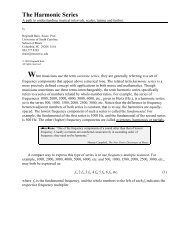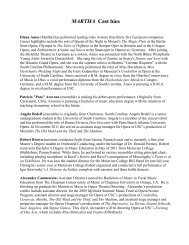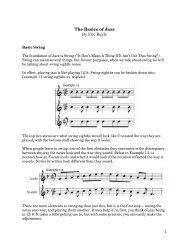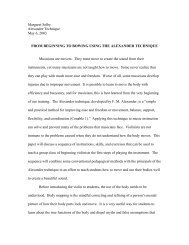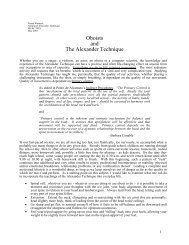Lauren Remmers 11/20/07 Alexander Technique- final presentation ...
Lauren Remmers 11/20/07 Alexander Technique- final presentation ...
Lauren Remmers 11/20/07 Alexander Technique- final presentation ...
Create successful ePaper yourself
Turn your PDF publications into a flip-book with our unique Google optimized e-Paper software.
<strong>Lauren</strong> <strong>Remmers</strong><br />
<strong>11</strong>/<strong>20</strong>/<strong>07</strong><br />
<strong>Alexander</strong> <strong>Technique</strong>- <strong>final</strong> <strong>presentation</strong><br />
<strong>Alexander</strong> technique is, first and foremost, about the care and nurture of the spine.<br />
By studying our bodies and <strong>Alexander</strong>’s principals, we can better learn to move freely,<br />
easily, and with less tension. We can also make old conceptions of “posture” obsolete by<br />
learning what is actually healthy for us. <strong>Alexander</strong> technique can aid in flute playing in<br />
multiple ways which teach a musician to focus and be expressive while still caring for the<br />
spine. The techniques which are essential to the action of playing flute involve breathing<br />
movement, arm movement, and jaw movement.<br />
Breathing is something with which all musicians will struggle at some point.<br />
Particularly in quicker passages, the pressure is on to take in as much air as possible in as<br />
short a time as possible. This pertains especially to flute because it is an instrument that<br />
requires an enormous air supply, as only a portion of the air that leaves the players’ lungs<br />
ends up in the instrument and actually contributes to the sound. The rest is expelled into<br />
the air. This is unlike most wind instruments that have a mouthpiece reaching completely<br />
inside the player’s mouth and therefore 100% of the air used goes directly into their<br />
instrument. Given this need for extra air output, trying to catch quick breaths can easily<br />
produce tension in a flute player’s throat. This can lead to several complications<br />
including gasping or breaths that sound to loud or high-pitched, and this can become<br />
distracting to a player’s performance. When there is tension in the throat, it is also<br />
impossible to fill the lungs to their full capacity in a short time, leading to shallower
eathing and the inability to complete phrases in one breath. In order to achieve proper<br />
breathing, a player must understand how the process works. When the diaphragm pulls<br />
downward, air first rushes inside the mouth and THEN into the lungs. There should be a<br />
widening and deepening in the torso and the spine should lengthen on the exhale and<br />
gather on the inhale. It is also best to do a tiny head nod before playing to make sure<br />
your head is properly aligned on the A.O. joint (between the ears!) and that there is no<br />
excess tension in the neck. With knowledge of the breathing muscles and awareness of<br />
any tension entering the neck, a flute player will be able to remain relaxed and loose and<br />
take quick breaths that don’t sound obtrusive.<br />
When playing flute, it is important to be flexible with the direction of the air in<br />
order to play in all octaves. However, it is very easy to develop excess tension in the jaw<br />
joint which causes the player to be stiff (and also spreads tension to the neck). For flute<br />
players, this is a common occurrence because the flute rests on the jaw below the mouth,<br />
and for all wind players, improper care of the jaw can lead to discomfort, stiffness, and<br />
even popping in the joint. The best way to prevent such things from happening is to<br />
always move the jaw in an easy, fluid motion. It should swing down and slightly back,<br />
which is contrary to most people’s body maps which tell them they should swing it<br />
straight down or even down and forward, causing the chin to jut out. This is never good<br />
for the jaw. Another body mismapping occurs in the actual location of the jaw joint, or<br />
the temporomandibular joint. There are two, both of which are located below and<br />
slightly in back of the temples (in front of the ears). Often, students assume their jaw is<br />
connected to the skull at a much lower position, as if the chin were the whole jaw, and<br />
this should be corrected quickly as it can lead to problems which will prevent them from
achieving the natural, flexible sound that is characteristic of the flute. This jaw motion<br />
will also aid in a more relaxed intake of air when the player opens their mouth to breathe.<br />
Some players who have experienced problems with jaw movement also avoid actions<br />
such as chewing gum or eating very tough food that is hard to chew.<br />
The first movement a flute player has to make is with the arms, to bring the<br />
instrument up to playing position. Several issues arise here because the members of the<br />
flute family are the only transverse wind instruments and thus, they call for more arm<br />
extension than most other instruments. Holding the right arm out to the side for an<br />
extended period can be very difficult, especially if the arm structure is incorrectly<br />
mapped, and can create tension in the muscles surrounding the shoulder blade. The left<br />
arm structure also can become strained if it is not positioned correctly and can even pinch<br />
nerves. This can lead to numbness of the arms and can even interfere with expansion<br />
while breathing. The arm structure must be correctly mapped so as to avoid these<br />
injuries, and this is a common problem because the majority of musicians think there are<br />
only three arm joints. There is actually a fourth joint at the collarbone: the<br />
sternoclavicular joint. This is where all arm movement should be supported from<br />
initially. It is an excellent idea to begin with some arm warm-ups before picking up the<br />
flute. Floating the arms up by your sides while leading from the collar bone will really<br />
loosen up the joints and teach students to bear the weight from the proper place, relieving<br />
much excess tension. Arm circles work quite well too. Also, when positioning the arms,<br />
it is important to remember that the left arm structure should be moved significantly<br />
forward to avoid the strain that is common to this arm. Use of the arms should not create<br />
excess tension in the neck either, so one should always check to see that the neck is free
and loose. When bringing the flute to the face, swinging it around in a wide circle in<br />
playing position will really help get those arms extended and encourage proper use of the<br />
arm structure. Of course, when playing, the student should do their best to remain<br />
relaxed and avoid tensing the arms or fingers.<br />
Musicians can become injured just by overuse and misuse of their bodies while<br />
playing, but with the application of the <strong>Alexander</strong> technique to care for the spine, one can<br />
continue playing well into their life. Even simple activities such as practicing on an<br />
exercise ball can help maintain alignment (or you’ll lose your balance!), and forward<br />
spinal rolls help relieve tension in the back. When playing in an ensemble where sitting<br />
is required, a flute player can even lay forward over their lap and relax their spine in this<br />
way. When flute players master breathing, jaw, and arm movements, their body can<br />
work together as one and move in a more fluid, easy style which can protect them from<br />
many potential injuries.<br />
Sources:<br />
What Every Musician Needs to Know About the Body: The Practical Application<br />
Of Body Mapping to Making Music by Barbara Conable. 1998.



